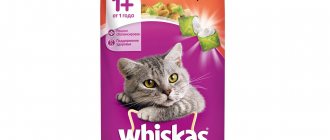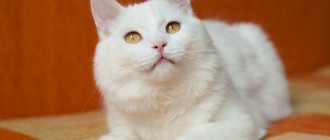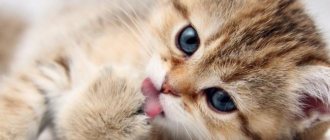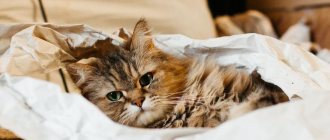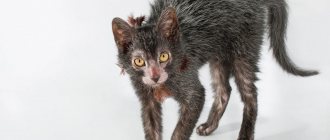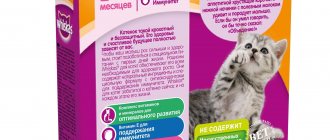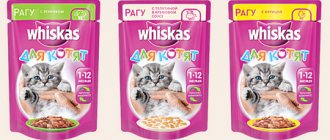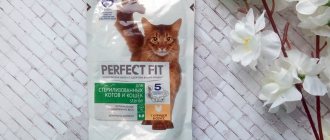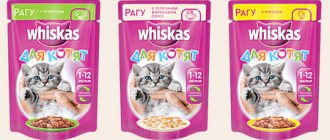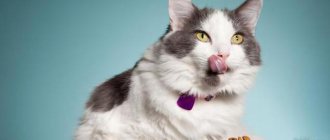Whiskas for kittens and adult cats is one of the most famous and frequently advertised foods on TV. However, commercials are not a guarantee of quality. In the feed rating, Whiskas products occupy the last positions.
To avoid possible pet health problems, cat lovers need to know what Whiskas commercial food is made from.
Brand history
American corporation Mars specializing in food production. In 1932, the company released cat food called Whiskas. In English, Whiskas sounds similar to Wiskers, which translated means “mustache, vibrissae.”
New formulas and formulations are developed at the Waltham research center, which is located in the United Kingdom. Thanks to the merits of researchers, the benefits of taurine for cats have been proven. The company was the first to add this substance to its animal products.
The company's factories are located all over the world. At the moment, the manufacturer has already opened several factories in the Russian Federation.
Range
Whiskas provides ready-made food for spayed and neutered cats, kittens, adult and aging pets. Whiskas for kittens is sold in the form of dry food, pouches and pate. The manufacturer claims that the composition contains everything necessary for the healthy growth of your baby.
Whiskas diets for kittens from 1 to 12 months and older cats come in a variety of flavors:
- Salmon stew is small, tender pieces of salmon in a flavorful sauce. The high content of nutrients and minerals makes the kitten food balanced.
- Rabbit and Turkey Stew is more suitable for adult cats. It contains vitamin E, which is responsible for reproductive function and oxidative processes in the body.
- Delicious stew with beef and lamb. The composition includes: by-products, ash and fiber. It is recommended to give to a cat after 1 year.
- An appetizing stew with chicken in a thick creamy sauce will give your pet an indescribable taste sensation. Cream soup from Whiskas is another new product from the company.
- An appetizing stew with rabbit is introduced into the cat’s diet after 1 year of life. With beef and rabbit, crispy pillows are available with vegetable additives.
- Turkey Jell-O provides delicious meaty turkey bites with just the right balance of minerals. The formula was specially developed for babies.
- Jelly with veal - the kitten will be happy to try small tender pieces of meat with veal. The main source of protein is beef and offal. The lean component of the feed is rice.
- Mini fillet with chicken. New product from Whiskas. Tender chicken pieces are filled with meat jelly.
- An appetizing veal pate is intended for aging animals. It does not contain grain crops, and the calorie content is 700 kcal per kilogram of weight.
Whiskey chappy and other rubbish……….
There are four of the most terrible, most poisonous animal foods on the planet - these are Whiskas and Kiteket for cats, and Pedigree and Chappy for dogs, these are economy class food, although in terms of price I would classify Whiskas as premium, but in terms of quality they are not all economy - and... well, there are simply no words... If only you knew how many thousands of animals have already died in agony from this muck, how many millions of animals are ruining their health (main diseases: terrible dermatitis: rashes, hair loss, inflammation of the anal glands, scratching on a huge area, suppuration , and so on; gastrointestinal disorders: diarrhea, constipation, colitis, enteritis, gastritis, etc.; various allergies; renal failure; pancreatitis; terrible liver diseases (the liver is the main target, and it has the most terrible problems), and of course ICD ( urolithiasis) So, I’ll give you the most popular answers to exclamations like: “Under no circumstances feed Whiskas, it’s poison”
1) Well, my cat has been eating Whiskas for several years now, and everything is fine, no problems. Yes, indeed, in my practice there have been cases where a cat was on Whiskas for up to ten, even ten years without any special symptoms. Well, ten is a rare case, almost unique, but five is welcome. In such cases, we are dealing with a cat that is clearly very strong, with simply the most powerful and unusually stable metabolism, which neutralizes all these nasty things in some way unknown to science. Most often, such cats are relatively young (that is, they began to feed relatively early, almost from childhood) and they mostly live not in Moscow or in the city at all. But in any case, the argument is simply ridiculous - so you find out that you have been feeding the cat poison for many years, but the fact that the cat still has not died makes you ask: “well, if it has not died yet, and in general looks great, then Maybe he’s not going to continue to die, so what am I going to change?” No, well, the logic is just super - if it’s gone for now, then you can continue to feed it, maybe it will survive, well, really - but what if it does survive? And I’ll tell you more, if you fed your cat Whiskas for several years without any symptoms, then even if you immediately stop the Whiskas diet and organize the most correct diet, you cannot guarantee that after some time problems will not come to light, and problems serious.
2) Well, my meow loves Whiskas bags so much, she’s absolutely thrilled by them, her heart bleeds not to give her at least one Whiskas bag!
Yes, sachets are now, perhaps, the most popular product in Whiskas, everyone is simply obsessed with sachets, and the reasons for this are completely objective. They, like other Mars foods, contain the same hooves and feathers, but here, so that these hooves are eaten with appetite, they add, in addition to ordinary synthetic flavors, attractants
Special chemical additives (attractants), a secret of Whiskas-Friskies-Kittyket, which make the food very tasty for cats.
If you pour sprat oil on sawdust, some cats would eat it, and so do the same here. Attractants) so that it seems very tasty to cats. Without them, the cat wouldn’t even look at whiskey. (including, probably, sexual) substances that are addictive, almost drugs, as a result, the animal turns out to be a real drug addict who cannot eat anything but this poison.
Does this mean that you can just let everything take its course and continue feeding the cat drugs in the name of its well-being? Of course not, it will get worse and worse. Weaning a cat off pouches in serious cases is a real science. It is necessary to translate for MONTHS so that the cat does not scratch out your eyes, and so that the animal does not suffer from anorexia (refusal of food, most often the consequences of this are not only weight loss and dystrophy, the heart suffers from it in cats, as a result, heart failure is also superimposed on the picture ), or even died.. First, you just add other foods to Whiskas drop by drop, and mix it with Whiskas so that the patient does not realize that there is something there, then gradually, imperceptibly for the cat, increase the content of the additive in Whiskas, so so that by the last month of transfer you spend one or two sachets a week, mixing them with other products. Well, then you can already treat the consequences of this Whiskas. As a result, even a rescued animal remains disabled forever (if fed these bags for a long time), and is forced to sit on completely tasteless medicinal food until death. The owner also pays for his frugality (he wanted to save on food), and pays a huge amount of money to the veterinarian, and then buys expensive medicinal food and medicines, and also receives wounds from his cat every time he feeds her this nasty stuff (food for liver disorders - the most tasteless food in any series of medicinal products)
What are cheap industrial feeds made of (Whiskas, Kitikat, Chappie, Pedigree)?
A wide variety of animal waste (heads, hooves, horns, beaks, esophagus, intestines, lungs, kidneys, spleen, blood, subcutaneous fat, tendons, etc.), as well as parts of carcasses that were not used in production " human" food (sites of administration of hormones and antibiotics, areas of damage, tumors, including malignant ones, etc.). The corpses of fallen, roadside and euthanized pets - the San Francisco Chronicle wrote about this, feed manufacturers angrily denied this fact, and the American Veterinary Medical Association confirmed it. Expired meat products from supermarkets. Since most companies producing feed are branches of food industry giants, by processing by-products of the main production in this way, they practically achieve zero waste.
Some of the animal proteins are replaced by plant proteins, obtained, in particular, from soybeans, which often cause flatulence, corn - but not grain, but cobs, cake, moldy peanut shells containing aflatoxins secreted by the fungus - the last component in one of the types of feed 15%, etc.).
This practice is particularly noted: ingredients originating from the same source are divided into groups and listed in that order on the packaging, with the result that in terms of percentage composition they occupy, for example, 2nd and 3rd places, although in terms of their overall content they should come first. In addition, it is allowed to preserve the composition of the feed prescribed on the packaging for six months, even if it has actually undergone changes. And for feeds with the so-called open formula, this is the rule, despite the fact that their composition is constantly changing depending on the market value of the components.
Fats are a mixture of spoiled and rancid fats of the most diverse origin. What is added to cheap industrial food (Whiskas, Kitikat, Chappie, Pedigree)? Sodium nitrite is often used as a colorant (especially in red foods) and a stabilizer - in interaction with gastric juice and food components, it is a powerful carcinogen.
Synthetic preservatives and antioxidants. Some additives - BHT (butylated hydroxytoluene), BHA (butylated hydroxyanisole), which are used in the “human” food industry and have long been suspected of carcinogenicity, as well as ethoxyquin and propyl gallate - increase the toxicity of other chemicals substances, mutagenic activity, the body's sensitivity to radiation and the influence of chemical carcinogens. According to John Cargill, there is no doubt that in certain quantities synthetic antioxidants provoke or promote the growth of neoplasms. For dogs, this amount has not been determined and the problem has never been properly studied. Ethoxykin (effective as an insecticide and pesticide, used as a stabilizer in rubber production, has many similarities with Agent Orange) is prohibited in the human diet and has been classified as a toxic substance by the US Food and Drug Administration (FDA). In small doses, it was once approved as a preservative in the production of feed from alfalfa and clover for farm animals. It is found in much higher doses in pet foods. Its use in animals leads to immunodeficiency syndrome, liver and stomach cancer; in people exposed to it at work - liver and kidney damage, skin cancer, baldness, blindness, leukemia, congenital deformities and chronic diarrhea. The listed diseases can also occur in animals. Used because it is the cheapest and most effective preservative known. The worst thing is that it is impossible to detect its presence in finished food, and therefore to convict the manufacturer of violating the law.
Now decide for yourself what to feed and what not to feed your beloved cat and dog...
Analysis of dry food composition
The company produces only one type of Whiskas dry food for kittens - air pads. Manufacturers do not hide the fact that dry food contains various types of flour, the mass fraction of which is at least 4%, and by-products. This recipe makes the food grain-based and lacks the required amount of protein. Manufacturers also add brewer's yeast, animal fat and vegetables to Whiskas.
Whiskas dry food helps prevent the formation of tartar and the development of gastrointestinal diseases in kittens.
Feeding the cat
The energy value and digestibility of Whiskas is low. The package indicates a daily allowance of 70 g, but cats do not get enough of this portion. In fact, the daily ration is 100-120 g. Pregnant and lactating cats require even more.
100-120 g of dry food requires 250-300 ml of liquid. A cat is not able to drink that much water. Excess mineral salts lead to increased urine concentration and the appearance of sand and stones. There is constant dehydration of the body. The inability of the predator’s stomach to digest wheat and soy causes digestive disorders and allergic reactions.
The average lifespan of a cat is 13-15 years. With good nutrition and care, the animal can live 15-20 years.
If Whiskas is the main or only food for a cat, the animal rarely lives to see its tenth birthday. The average life expectancy of such animals is 5-7 years.
Problems that appear after 2-3 years:
- urolithiasis disease;
- dermatitis - itching, skin rashes, hair loss;
- Gastrointestinal diseases - nausea, alternating constipation and diarrhea;
- pancreatitis, liver pathologies;
The main cause of death of the animal is uric acid poisoning.
The harmfulness of inadequate feeding causes irreversible consequences. If a sick cat is switched to high-quality food, this will not restore its health.
Savings when using cheap feed is a myth. When feeding Whiskas, approximately 3.3 kg are consumed per month. A pack of 800 g costs 140 rubles. A cat’s diet with harmful pads will cost the owner 600 rubles. 1.5 kg of Royal Canin premium food costs about the same, a package of which lasts for a month.
The cost of Whiskas includes the costs of intrusive advertising and chemicals that mask the low-grade composition of the product. After deducting costs, the real price of crackers is comparable to the cost of stale bread.
Cheap pads are especially harmful for kittens, elderly cats, pregnant and lactating cats.
Veterinary costs are significantly more expensive than proper, healthy nutrition.
Pet owners who feed their cats Whiskas take away several years of their pet’s life and condemn them to painful old age with chronic diseases.
Wet food composition analysis
The composition of Whiskas food in pouch is different from dry food and contains only a few components. Mass fraction of meat and offal - 8.5%. The cereal components make Whiskas rich in carbohydrates. Taurine, vitamin and mineral complexes maintain the natural balance of the body.
Whiskas wet cat food is considered an economy class food. The factory packaging of the jelly does not indicate the exact amount of meat, its type, or which by-products were used in the feed compositions.
The manufacturer does not inform consumers about which specific products are used in wet food - high-quality or potentially dangerous.
Consequences
Do you know why kittens gobble up Whiskas with such gusto? It contains a substance that is addictive. The kitten becomes a “drug addict” from childhood.
If cheap food is the mainstay of your kitten's diet, be prepared for the following consequences:
- developmental and growth delays;
- skin rash, dandruff, hair loss;
- vomiting due to overeating;
- dependence on food (the cat “shakes” at the sight of a bag);
- sand, kidney stones;
- liver diseases;
- stomach ulcer, gastritis.
These are the main consequences faced by cat owners who have shared their problems on forums. In all cases, veterinarians at local clinics say it is due to the animal's diet.
Scottish Straight: description of the breed
03/13/2018 1 review 89,
The Scottish Straight belongs to the category of popular shorthair cats. These are children of Scottish Fold cats, who, upon reaching the age of six months, remained straight-eared; recently they have become an independent breed. This division became necessary for the competent crossing of Scottish cats.
The homeland of these animals is Scotland. This breed was obtained by crossing with a Scottish fold cat. The lop-eared gene, which mutated hundreds of years ago, does not give all kittens curved ears; in some of them, the ears straighten after the first month of life, which forced them to be divided into Scottish Folds and Scottish Straights.
general information
Whiskas is an economy class food produced by the American company Mars. The company has been producing cat products since 1958. During this time, Whiskas became widespread on the market and became world famous, but not very positive reviews from veterinarians.
Cats eat with pleasure and love this food; many owners note that it is quite difficult to wean their pet off Whiskas. Couldn't this be an indicator of good selection and quality? Before deciding whether Whiskas is beneficial or harmful to your pet’s body, you must carefully study the composition of the product and draw the appropriate conclusions. After analyzing the composition, it will become clear whether it is possible to feed a cat Whiskas.
